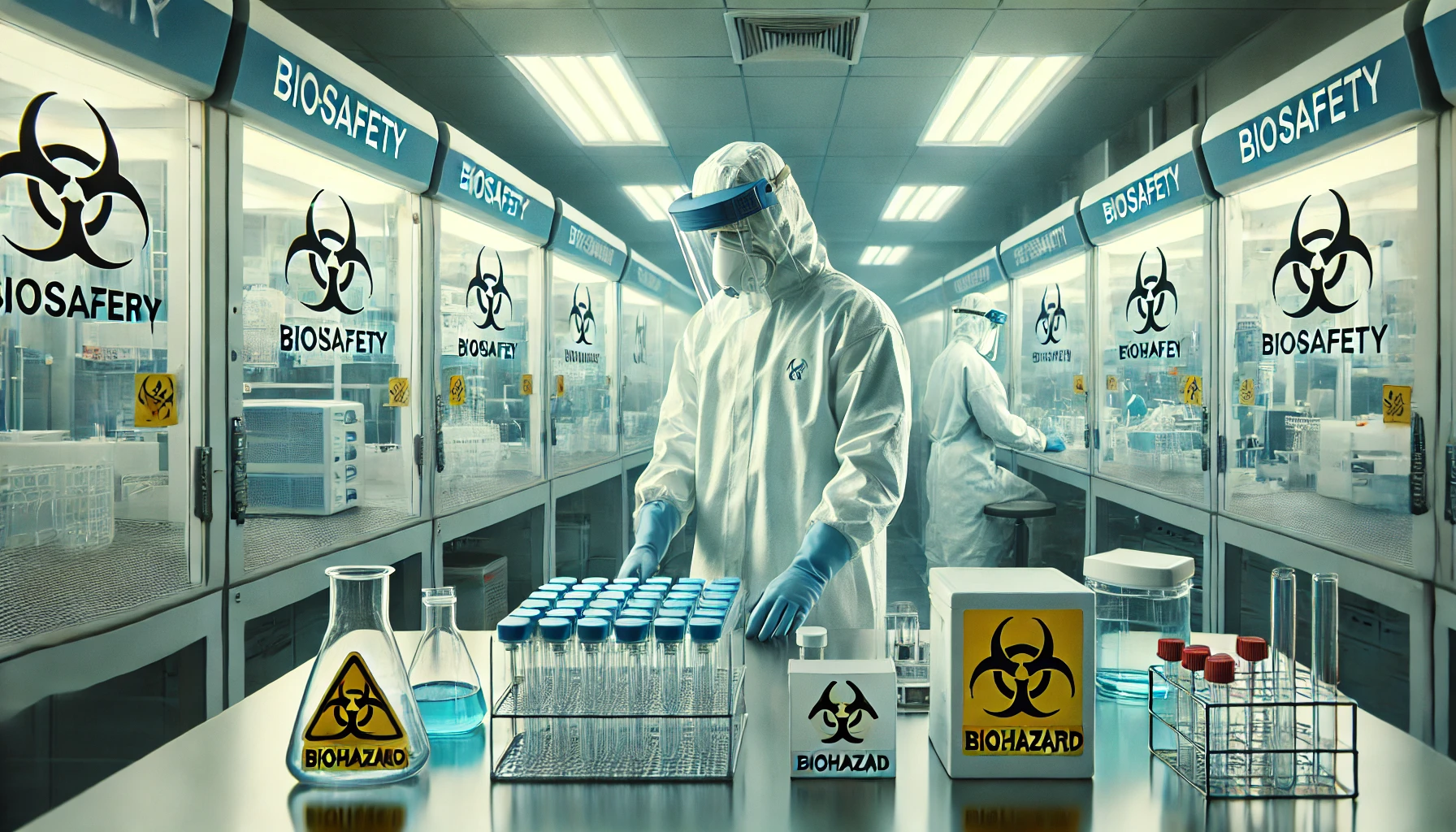Biosafety refers to the principles, practices, and protocols used to prevent accidental exposure to potentially harmful biological materials, as well as to safeguard the environment and public health. It plays an essential role in laboratories, hospitals, research facilities, and industries where microorganisms, infectious agents, or hazardous biological substances are handled. By understanding and applying the basic principles of biosafety, individuals can work safely with biological agents while minimizing risks.
Introduction to Biosafety
Biosafety is fundamentally about managing and controlling the risks associated with biological research and biotechnological applications. Whether handling bacteria, viruses, or genetically modified organisms (GMOs), scientists and healthcare professionals must follow specific protocols to avoid contaminating the environment or exposing themselves and others to harmful pathogens.
The basic principle of biosafety focuses on creating a safe working environment that protects both workers and the public. This principle is built around a framework of safety measures, which include biological containment, personal protective equipment (PPE), engineering controls, and well-structured laboratory protocols.
What is the Basic Principle of Biosafety?
The basic principle of biosafety involves identifying potential hazards and implementing measures to prevent those hazards from causing harm. The guiding idea is to control risks by applying a combination of practices that include:
- Risk assessment: Identifying the type of hazard and its likelihood of causing harm.
- Containment practices: Using physical and procedural controls to prevent the release of harmful biological agents.
- Safe handling procedures: Developing and following safety guidelines for handling biological agents.
- Training and education: Ensuring that all personnel working with biological materials are properly trained in biosafety principles.
In essence, the basic principle of biosafety is about risk management, understanding the dangers posed by biological materials, and applying the appropriate safety measures to minimize those risks.
Key Components of Biosafety
To better understand the basic principle of biosafety, it’s important to explore its key components. Each component plays a crucial role in protecting laboratory personnel, the public, and the environment from potentially dangerous biological agents.
1. Risk Assessment
Risk assessment is one of the core elements of biosafety. It involves evaluating the risks associated with the biological agents being handled and determining the necessary precautions to mitigate those risks. This process includes:
- Identifying the biological agent’s potential to cause disease.
- Understanding how the agent can be transmitted (e.g., through inhalation, skin contact, or ingestion).
- Evaluating the severity of the disease caused by the agent.
- Considering the availability of treatments or vaccines for potential exposure.
The results of the risk assessment will determine the biosafety level (BSL) required to safely work with the biological agent.
2. Biosafety Levels (BSLs)
Biosafety levels are graded from 1 to 4, with each level corresponding to the degree of risk posed by the biological agents being handled. The higher the BSL, the more stringent the safety precautions.
- Biosafety Level 1 (BSL-1): This level applies to work with agents that pose minimal potential hazards to personnel and the environment, such as non-pathogenic strains of E. coli. Standard microbiological practices are followed.
- Biosafety Level 2 (BSL-2): Agents handled at this level pose moderate risk and may cause mild diseases, such as hepatitis B or HIV. Personnel must follow additional safety precautions, including the use of gloves, lab coats, and biological safety cabinets.
- Biosafety Level 3 (BSL-3): Work at this level involves agents that can cause serious or potentially lethal diseases, such as Mycobacterium tuberculosis. Laboratories require more stringent controls, such as specialized ventilation systems and restricted access.
- Biosafety Level 4 (BSL-4): This is the highest level of biosafety, required for work with agents that pose a high risk of aerosol-transmitted infections and for which there is no known cure, such as the Ebola virus. Personnel must use full-body, air-supplied suits, and work is conducted in isolated facilities with rigorous containment measures.
Each BSL ensures that the level of containment and safety measures matches the level of risk posed by the biological agent being studied.
3. Containment Measures
Containment refers to the set of practices, equipment, and facilities designed to prevent exposure to hazardous biological agents. There are two primary types of containment:
- Primary containment: This protects the individual working with the biological material. Examples include biological safety cabinets (BSCs), personal protective equipment (PPE), and proper hand hygiene.
- Secondary containment: This involves protecting the environment outside the laboratory from contamination. Examples include proper laboratory design, air filtration systems, and restricted access to the lab.
Both types of containment are crucial in biosafety protocols to ensure that dangerous agents remain confined within designated areas and do not escape into the environment or harm laboratory personnel.
4. Personal Protective Equipment (PPE)
Personal protective equipment is essential in the field of biosafety. It includes items such as:
- Gloves: To protect hands from direct contact with hazardous materials.
- Lab coats: To protect clothing and skin from exposure.
- Safety goggles: To shield the eyes from splashes or aerosols.
- Face masks or respirators: To protect against inhaling airborne pathogens.
The correct use of PPE is a fundamental aspect of the basic principle of biosafety. All personnel handling biological materials should be trained in the proper use and disposal of PPE to reduce the risk of exposure to harmful agents.
5. Engineering Controls
Engineering controls are physical changes to the work environment that reduce the risk of exposure to harmful biological agents. These controls include:
- Biological safety cabinets (BSCs): Enclosed, ventilated workspaces that protect laboratory workers from exposure to airborne particles and aerosols.
- Fume hoods: Similar to BSCs, these are designed to capture and remove airborne contaminants.
- Autoclaves: Devices that use high-pressure steam to sterilize equipment and materials, effectively killing any biological agents present.
Engineering controls are an integral part of laboratory design and are used in combination with procedural controls to maintain a safe working environment.
6. Safe Laboratory Practices
One of the most effective ways to ensure biosafety is by adhering to well-established laboratory practices. These practices are designed to reduce the risk of accidental exposure to biological agents. Some important practices include:
- Proper hand hygiene: Washing hands before and after handling biological materials.
- Disinfecting work surfaces: Regular cleaning of work areas to prevent contamination.
- Correct disposal of biological waste: Using autoclaves or chemical disinfectants to safely decontaminate waste materials.
- Labeling and storing biological agents: Properly labeling containers and storing hazardous materials in designated areas.
By following these practices, laboratory personnel can significantly reduce the risk of accidents or exposure to harmful biological agents.
7. Training and Education
Training is a critical component of biosafety. Personnel must be educated on the risks associated with biological materials and trained in the proper safety protocols. This includes:
- Understanding the types of biological hazards.
- Learning how to use PPE and engineering controls.
- Being familiar with emergency procedures in the event of exposure or contamination.
Regular training updates and assessments help ensure that all personnel are up-to-date on the latest biosafety protocols, minimizing the risk of accidents and maintaining a safe working environment.
Application of the Basic Principle of Biosafety in Various Settings
The basic principle of biosafety applies not only in research laboratories but also in other environments where biological materials are handled. This includes healthcare facilities, pharmaceutical companies, agricultural industries, and even public health sectors. Let’s explore how biosafety principles are applied in different fields.
Biosafety in Healthcare Settings
In hospitals and healthcare facilities, biosafety measures are crucial to prevent the spread of infections. Healthcare workers are often exposed to infectious agents, including bacteria, viruses, and fungi, which can lead to outbreaks if not properly contained. Some key biosafety measures in healthcare settings include:
- Use of PPE: Healthcare workers use gloves, gowns, masks, and eye protection when dealing with patients who may be infectious.
- Infection control procedures: Hand hygiene, sterilization of equipment, and isolation of patients with contagious diseases are essential to prevent the spread of infections.
- Vaccination of healthcare workers: Immunization against common pathogens, such as hepatitis B and influenza, helps reduce the risk of infection.
By following these practices, healthcare workers can protect themselves and their patients from potentially harmful pathogens.
Biosafety in Research Laboratories
Research laboratories handle a wide variety of biological agents, ranging from harmless organisms to highly dangerous pathogens. Biosafety protocols are critical in these settings to prevent accidental exposure or release of these agents into the environment. Some key biosafety practices in research laboratories include:
- Strict adherence to BSL requirements: Depending on the biological agent being studied, laboratories must comply with the appropriate biosafety level protocols.
- Use of biological safety cabinets: Researchers work in BSCs to contain airborne particles and aerosols that could pose a risk.
- Decontamination of equipment and surfaces: Regular cleaning and disinfection of lab equipment and surfaces ensure that any biological agents are safely neutralized.
Biosafety in Agricultural and Environmental Fields
Biosafety is also important in the agricultural and environmental sectors, where the handling of genetically modified organisms (GMOs), pesticides, and biological control agents can impact the environment and public health. In these settings, biosafety measures include:
- Safe handling of GMOs: Ensuring that GMOs are contained and do not accidentally spread to the environment.
- Regulation of biological control agents: Using appropriate safety measures when releasing biological agents to control pests or diseases in agriculture.
- Preventing the spread of zoonotic diseases: Applying biosafety principles to prevent the transmission of diseases from animals to humans in farming and wildlife management settings.
Biosafety in Public Health
In the public health sector, biosafety principles are used to control the spread of infectious diseases and manage outbreaks. Public health professionals must be vigilant in identifying potential hazards and implementing safety measures to protect the population. Key biosafety measures in public health include:
- Surveillance of infectious diseases: Monitoring the spread of diseases and implementing containment measures.
- Vaccination programs: Ensuring that populations are vaccinated against dangerous pathogens, such as measles, polio, and COVID-19.
- Rapid response to outbreaks: Deploying biosafety measures, such as quarantine and isolation, to prevent the spread of infectious diseases during outbreaks.
Challenges in Biosafety
Despite the implementation of biosafety principles, challenges still arise in various fields. Some of these challenges include:
- Emerging pathogens: The constant emergence of new and unknown pathogens poses a challenge to biosafety measures, as existing protocols may not be sufficient to handle novel threats.
- Antimicrobial resistance: The rise of antimicrobial resistance complicates the treatment of infections, making biosafety even more critical to prevent the spread of resistant strains.
- Globalization: Increased travel and trade have made it easier for diseases to spread across borders, highlighting the need for international collaboration on biosafety measures.
These challenges emphasize the importance of continuously improving and updating biosafety protocols to address emerging threats.
Conclusion: The Importance of the Basic Principle of Biosafety
The basic principle of biosafety is essential for maintaining a safe environment when working with biological materials. By applying risk assessment, containment measures, proper laboratory practices, and effective training, individuals in research, healthcare, agriculture, and public health can minimize the risks posed by harmful biological agents. Biosafety is a critical component of modern science, ensuring that we can continue to explore the mysteries of biology while protecting ourselves, the environment, and the public from potential dangers.













